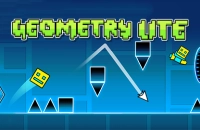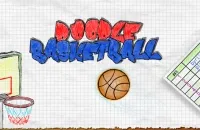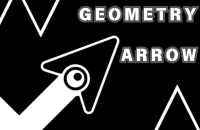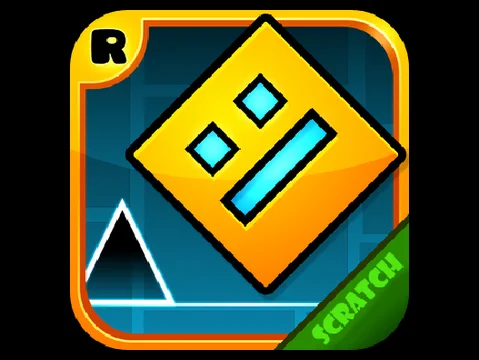Geometry Dash Lite
Geometry Dash Lite
Connecting to game server...
0% complete

Geometry Dash Lite
Click to start playing
🕹️ You May Also Like












Geometry Dash Lite
Experience addictive rhythm-based platforming challenging reflexes through synchronized obstacles and beats. Master one-touch controls across difficult levels.
Geometry Dash Lite is the free version of the popular rhythm-based platformer. Navigate your geometric character through increasingly difficult levels filled with spikes, platforms, and moving obstacles. Each level is perfectly synchronized with energetic electronic music, creating an immersive experience that challenges your timing and reflexes. The game features simple one-touch controls but requires precise timing to master.
🎮 How to Play
- 1Click or Space to jump
- 2Hold to fly in ship mode
- 3R to restart level
💡 Game Tips
- 💡Listen to the music rhythm for perfect timing
- 💡Practice mode helps you learn difficult sections
- 💡Watch for visual cues that sync with the beat
- 💡Start with easier levels to build muscle memory
📚Complete Strategy Guide
Master Geometry Dash Lite with our comprehensive guide and pro tips
Basic Strategy
Geometry Dash Lite is the perfect introduction to the rhythm-based platformer series, offering challenging yet accessible gameplay that tests your reflexes and timing. The key to success lies in understanding that every obstacle is synchronized with the music, making the soundtrack your most valuable guide.
Master the Rhythm: The most fundamental strategy is to listen carefully to the electronic beats. Each jump, spike, and obstacle is perfectly timed with the music. Instead of relying purely on visual cues, train your ear to predict when to jump. The bass drops often indicate major obstacles or platform changes.
Start Slow: Don't rush through levels. Practice mode is your best friend - use it to learn the exact timing of difficult sections without the pressure of starting over completely. Focus on consistency rather than speed, as Geometry Dash Lite rewards precise timing over hasty button presses.
Visual Focus: Keep your eyes slightly ahead of your character rather than directly on it. This gives you crucial milliseconds to react to upcoming obstacles. The game's visual design isn't just aesthetic - the color changes and visual effects often hint at what's coming next.
Advanced Tips
Memorization Techniques: Each level in Geometry Dash Lite has a fixed pattern that never changes. Break challenging sections into smaller segments and practice them repeatedly. Create mental landmarks - "after the third spike, there's a platform" - to build muscle memory.
Finger Positioning: Maintain a comfortable, relaxed grip on your device or mouse. Tension in your hands leads to mistimed taps and poor performance. Some players find that using two fingers alternately (for mobile) or using keyboard spacebar (for desktop) provides better control than mouse clicking.
Pre-Jump Strategy: In sections with rapid-fire obstacles, learn to pre-jump slightly before the visual cue appears. The game's physics allow for small timing windows that experienced players exploit. This is especially crucial in the more challenging sections where obstacles appear in quick succession.
Ship Mode Mastery: When the character transforms into a ship, the control scheme changes from tap-to-jump to hold-to-rise. Practice smooth, controlled movements rather than rapid tapping. Ship sections often require flowing motions that match the music's rhythm.
Wave Mode Control: The wave mode requires the smoothest control of all game modes. Unlike ship mode, the wave responds to continuous pressure with immediate directional changes. Practice making small, controlled adjustments rather than large movements.
Level Walkthrough
Level Structure Understanding: Geometry Dash Lite levels follow a predictable structure with increasing difficulty. The first 30% typically introduces the level's main mechanics, the middle 40% combines these mechanics with increased speed or complexity, and the final 30% presents the ultimate challenge combining all elements.
Obstacle Recognition: Learn to quickly identify obstacle types:
- Regular spikes: Require single jumps with standard timing
- Tall platforms: Need longer hold duration for higher jumps
- Moving platforms: Require timing adjustments based on platform position
- Portal sections: Change game modes and often require different input methods
Section-by-Section Breakdown:
Opening Section (0-25%): Focus on establishing rhythm and basic jump timing. This section is designed to sync you with the music, so use it to get comfortable with the beat.
Build-Up Section (25-50%): Obstacles become more frequent, often introducing new elements like platforms at different heights. Pay attention to visual cues that indicate timing changes.
Climax Section (50-75%): This represents the level's main challenge, typically featuring the fastest sequences and most complex obstacle combinations. Master this section through repeated practice mode sessions.
Final Section (75-100%): Often combines earlier patterns with increased speed or complexity. Stay calm and trust your muscle memory from practice sessions.
Game Mode Mastery and Transitions
Cube Mode Fundamentals: The default cube mode forms the foundation of all Geometry Dash skills. Master single-tap jumping and learn to vary jump timing based on obstacle height. The cube cannot change direction mid-air, so commit fully to each jump.
Ship Mode Advanced Techniques: Ship mode requires fundamentally different thinking—you control altitude rather than just jumping. Practice smooth altitude changes that follow the music's flow. Learn to anticipate narrow passages by adjusting height early rather than making last-second corrections.
Ball Mode Strategy: Ball mode allows gravity reversal with each tap, creating unique movement patterns. Practice the rhythm of alternating gravity to navigate wave-like patterns. Ball mode often appears in sections designed to test your ability to maintain complex rhythmic patterns.
UFO Mode Control: UFO mode combines elements of ship and cube—you control vertical movement but with discrete jumps rather than continuous flight. Master the timing between taps to maintain consistent altitude in narrow corridors.
Wave Mode Precision: Wave mode demands the most precise control, responding instantly to touch input. Develop muscle memory for smooth diagonal movements. Practice maintaining consistent angles through wave corridors rather than making sudden direction changes.
Robot Mode Dynamics: Robot mode features higher jumps and different physics. Learn the timing differences—robot jumps take longer to complete but cover more vertical distance. Adjust your rhythm to account for these longer air times.
Spider Mode Navigation: Spider mode allows teleportation between floor and ceiling with each tap. Master the instant switching required for spider sections and learn to anticipate which surface you'll need to be on for upcoming obstacles.
Practice Mode Optimization
Checkpoint Strategy: Place checkpoints strategically before difficult sections rather than randomly throughout the level. Focus on mastering 5-10 second segments before connecting them together.
Slow Motion Practice: Use practice mode's slower speeds to understand complex sections before attempting them at full speed. This builds the muscle memory necessary for successful completion.
Error Analysis: When you die repeatedly at the same spot, analyze whether it's a timing issue, input method problem, or lack of preparation. Different problems require different solutions.
Progressive Difficulty: Start practice sessions with easier sections to warm up, then gradually tackle more challenging areas. This builds confidence and maintains proper timing throughout your practice session.
Psychological Aspects and Performance
Pressure Management: Geometry Dash Lite can create intense pressure, especially when attempting to complete levels. Learn to stay relaxed during crucial sections—tension in your hands and arms leads to mistimed inputs.
Flow State Achievement: The best performances occur when you stop consciously thinking about individual obstacles and let muscle memory take over. This requires extensive practice but results in smooth, effortless-feeling gameplay.
Failure Recovery: Don't let repeated failures at the same section create negative momentum. Take breaks when frustration builds, and return with fresh focus. Every expert player has failed thousands of times.
Goal Setting: Set incremental goals—instead of aiming to complete the entire level immediately, focus on reaching specific percentage milestones consistently.
Technical Optimization
Device Performance: Ensure your device runs the game smoothly without frame drops or input lag. Inconsistent performance makes timing impossible to master.
Audio Quality: Use good headphones or speakers to hear the music clearly. The audio cues are crucial for successful gameplay, and poor audio quality handicaps your ability to time movements properly.
Control Method Selection: Experiment with different input methods (touchscreen, mouse, keyboard) to find what feels most responsive and comfortable for your playing style.
Visual Settings: Adjust brightness and reduce visual effects if they distract from obstacle recognition. Clear visibility of upcoming obstacles is more important than flashy graphics.
Community and Improvement
Video Analysis: Watch successful playthroughs of difficult sections to understand optimal timing and strategy. Pay attention to when experienced players make their inputs relative to the music.
Rhythm Training: Improve your general sense of rhythm through music games or simply by tapping along to music. Better rhythmic abilities directly translate to better Geometry Dash performance.
Patience Development: Geometry Dash Lite rewards patience and persistence over quick reflexes. Develop the mental discipline to practice difficult sections repeatedly without becoming frustrated.
Progress Tracking: Keep track of your best attempts and completion percentages to maintain motivation during challenging periods.
Conclusion: Mastering Rhythmic Precision
Geometry Dash Lite represents the perfect fusion of musical timing and precise platforming. Success requires developing both technical skills and mental discipline, combining quick reflexes with patient practice and systematic learning.
The journey from first attempt to level completion teaches valuable lessons about perseverance, pattern recognition, and the satisfaction of mastering complex skills. Each death brings you closer to understanding the level's rhythm, and each successful section builds confidence for the challenges ahead.
With dedicated practice and the strategies outlined in this guide, you'll develop the skills necessary to conquer Geometry Dash Lite's toughest challenges. The geometric obstacles await your perfectly timed touch.
Climax Section (50-75%): The most challenging part, usually featuring rapid obstacle sequences, mode changes, or complex patterns. This section separates beginners from intermediate players.
Final Section (75-100%): Often combines elements from earlier sections with increased speed or added complexity. Don't let excitement cause premature tapping - maintain your established rhythm.
Common Mistakes
Panic Tapping: The biggest mistake new players make is rapidly tapping when they see multiple obstacles. This almost always results in mistimed jumps. Instead, maintain the rhythm you've established, even when obstacles appear challenging.
Ignoring the Music: Players often focus entirely on visual cues and ignore the audio component. The music is specifically composed to guide your timing - use it as your primary timing reference.
Inconsistent Practice: Playing levels randomly without focused practice on difficult sections limits improvement. Identify your weakest sections and dedicate practice time specifically to those areas.
Wrong Difficulty Progression: Jumping to harder levels before mastering the basics leads to frustration and bad habits. Complete each level multiple times before moving to the next difficulty tier.
Poor Failure Analysis: When you fail, don't immediately restart. Take a moment to understand what went wrong - was it timing, positioning, or rhythm? Understanding failure patterns helps prevent repetition.
Score Optimization
Completion Percentage: Your primary score in Geometry Dash Lite is completion percentage, which increases as you progress further in each level. Focus on consistent advancement rather than perfection in early attempts.
Attempts Management: While there's no penalty for multiple attempts, tracking your attempt count helps measure improvement. Set goals like "complete this section in under 20 attempts" to maintain motivation.
Stars and Achievements: Completing levels unlocks stars and achievements that track your overall progress. These serve as long-term goals and provide a sense of progression beyond individual level completion.
Practice vs. Normal Mode: Use practice mode to learn sections, but remember that normal mode completion is required for official progress. Don't rely too heavily on practice mode checkpoints - build the stamina to complete full levels.
Personal Best Tracking: Keep track of your best completion percentage for each level. This creates personal challenges and helps identify which levels need more attention.
Final Pro Tips
Patience is Key: Geometry Dash Lite is designed to be challenging, and failure is part of the learning process. Each attempt teaches you something new about timing, positioning, or rhythm.
Community Resources: Watch gameplay videos to see how experienced players handle difficult sections, but don't copy blindly - find techniques that work with your reaction time and playing style.
Regular Breaks: Extended play sessions can lead to decreased performance due to fatigue. Take breaks to maintain peak concentration and avoid developing bad habits from tired play.
Hardware Considerations: Ensure your device has good touch responsiveness (for mobile) or that your keyboard/mouse is responsive (for desktop). Input lag can significantly impact performance in a timing-based game.
Remember, Geometry Dash Lite is ultimately about the satisfaction of overcoming challenges through practice and persistence. Each successful completion represents mastery of complex timing and rhythm skills that transfer to more advanced levels in the series.